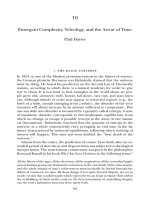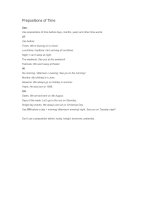Adverb clause of time
Bạn đang xem bản rút gọn của tài liệu. Xem và tải ngay bản đầy đủ của tài liệu tại đây (11.76 KB, 1 trang )
Adverb clause of time
An adverb clause of time shows when something happens. It is usually introduced by time adverbs. Examples
are: before, after, as, when, while, until, as soon as, since, no sooner than, as long as etc. Note that all
adverb clauses are subordinate clauses. They cannot stand on their own and must be attached to an
independent clause.
Read the examples given below.
I always take a bath before I go to bed.
Will you wait here until I am ready?
I was not at home when he came to see me.
Do not disturb me when I am busy with my work.
As soon as she finished that project, she started working on the next.
After I have finished my work, I will accompany you to the park.
Notes
An adverb clause of time can come before or after the main clause. When it comes before the main clause, we
usually separate it with a comma. Commas are not necessary when the adverb clause goes after the main clause.
Whenever I think of her, my eyes get misty.
My eyes get misty whenever I think of her.
Tense
If you are talking about something that is yet to happen in the future, use a present tense in the adverb clause
and a future tense in the main clause.
I will start when I am ready. (NOT I will start when I will be ready.)
I will not go until I get my money back. (NOT I will not go until I will get my money back.)
Stay on top of your writing! Download our grammar guide from www.englishgrammar.org to stay up-to-date.
Powered by TCPDF (www.tcpdf.org)









